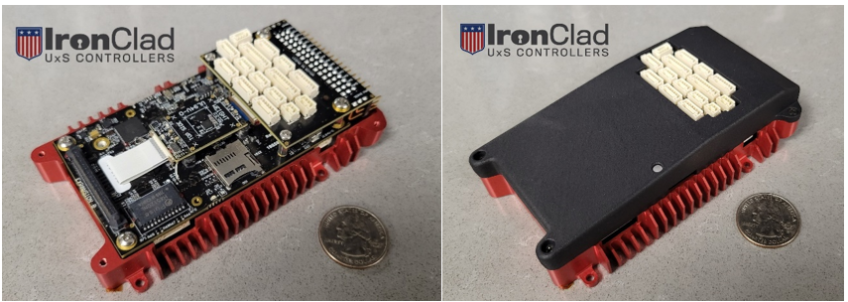Parallax Advanced Research Pioneers AAM Advancements in Ohio with Focus on Cybersecurity
Beavercreek, Ohio - Parallax Advanced Research has been actively driving advancements in cybersecurity for the Advanced Air Mobility (AAM) sector through its support of Asymmetric Technologies. This support has resulted in technology enhancements for Asymmetric’s IronClad Secure Flight Controller (SFC), a versatile embedded computing solution serving as both an autopilot and a mission computer for Unmanned Aircraft Systems. The IronClad SFC not only boasts robust security measures but also offers the flexibility to run various modules and applications on the same platform. The development of this technology was a collaborative effort involving The Ohio State University, Ohio University, and the Air Force Research Laboratory, with funding provided by the Ohio Federal Research Network (OFRN).
In the context of commercial AAM, cybersecurity assumes a critical role in safeguarding against unauthorized access and potential disruptions to unmanned aircraft systems (UASs) operations. The IronClad SFC, designed with cybersecurity in mind, serves as a cyber-secure, resilient open-architecture flight controller with advanced computational capabilities, enabling the integration of sophisticated intelligent autonomy functions.
"We've built this from the ground up to address security concerns, such as the initial user login being secure, ensuring that the right file systems are on board, and security of encryption keys in the event of a crash," stated Rob Hettler, president of Asymmetric Technologies. "If there's a crash event, the system wipes the encryption keys and ensures that nobody can get their hands on it."
Currently, most collision avoidance applications are based on the ground and rely on telemetry links to determine how to avoid collisions. In anticipation of the future of AAM, Asymmetric is actively developing a module, in collaboration with OFRN and the U.S. Air Force that will operate onboard unmanned aerial vehicles and perform collision avoidance autonomously. Achieving this level of autonomy in UASs demands a high degree of security and trustworthiness, which IronClad SFC offers. Furthermore, IronClad SFC is designed as an open-architecture software, making it a seamless and natural transition for companies already using lower-end open-source flight controllers, as it essentially utilizes the same software foundation.
"It's crucial for the general public that we approach everything from the software on unmanned aircraft to the prevention of potential hacker interference, which could lead to crashes or life-threatening situations, with a comprehensive perspective rather than addressing issues piecemeal,” said Hettler. “This is precisely what we're focusing on with IronClad."
In addition to creating a marketplace for IronClad, Asymmetric Technologies has been actively working to future-proof their technologies. Their goal is to ensure continued relevance and applicability, regardless of potential changes within the UAS and UAV ecosystem.
"This is where OFRN plays a crucial role. They are willing to support our ambitious ideas, offering funding and valuable networking opportunities to connect with the right partners,” said Hettler. “It has been highly effective for us, expanding our presence in the commercial marketplace that might have otherwise been challenging to access. Moreover, Parallax, being a nonprofit, offers unique advantages and resources that for-profit or smaller businesses may not have access to. From a partnership perspective, Parallax boasts a diverse pool of talent capable of developing capabilities like MTEC, which has the potential to serve as a long-term control station solution. Thus, our ongoing partnership with Parallax is immensely valuable, and we eagerly anticipate working together to grow this business and enable various AAM applications."
In the coming decade, Hettler envisions the emergence of a few significant players in the AAM industry. The industry's direction will largely depend on the Federal Aviation Administration’s regulations and the final frameworks they establish. Specifically, from a cybersecurity standpoint, Hettler anticipates that within the next five years, there will be greater clarity and maturity in defining and regulating not only cybersecurity but also collision-avoidance solutions and telemetry link regulations. This clarity will provide innovators with a clear roadmap for developing their technologies.
"Parallax possesses extensive reach and valuable connections within regulatory agencies, which can be instrumental for small businesses like ours in establishing essential connections in that sphere,” said Hettler. “Furthermore, I believe Parallax will also play a pivotal role in linking us with other businesses that share similar or complementary ideas, as they are currently doing. This collaboration will equip us to be well-prepared and successful within the mature AAM landscape.”
Close it out with how these technologies are being tested and used in environments that enable FAA and NASA for their AAM strategies/purposes to eventually have real live data and input so they can continue to create BVLOS and cybersecurity regulations for real-life operations.
###
About Parallax Advanced Research
Parallax Advanced Research is a 501(c)(3) private nonprofit research institute that tackles global challenges through strategic partnerships with government, industry, and academia. It accelerates innovation, addresses critical global issues, and develops groundbreaking ideas with its partners. With offices in Ohio and Virginia, Parallax aims to deliver new solutions and speed them to market. In 2023, Parallax and the Ohio Aerospace Institute (OAI) formed a collaborative affiliation to drive innovation and technological advancements in Ohio and for the Nation. OAI plays a pivotal role in advancing the aerospace industry in Ohio and the nation by fostering collaborations between universities, aerospace industries, and government organizations and managing aerospace research, education, and workforce development projects. More information about both organizations can be found at https://parallaxresearch.org/ and https://oai.org/.
About Ohio Federal Research Network (OFRN)
The OFRN has the mission to stimulate Ohio’s innovation economy by building statewide university-industry research collaborations that meet the requirements of Ohio’s federal laboratories, resulting in the creation of technologies that drive job growth for the State of Ohio. The OFRN is a program managed by Parallax Advanced Research in collaboration with The Ohio State University and is funded by the Ohio Department of Higher Education. https://ohiofrn.org/.



